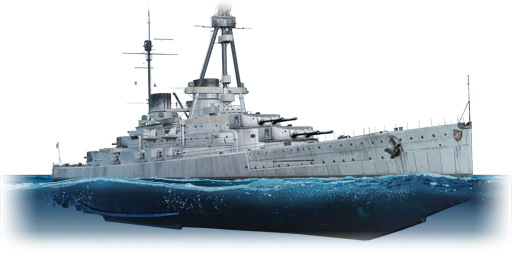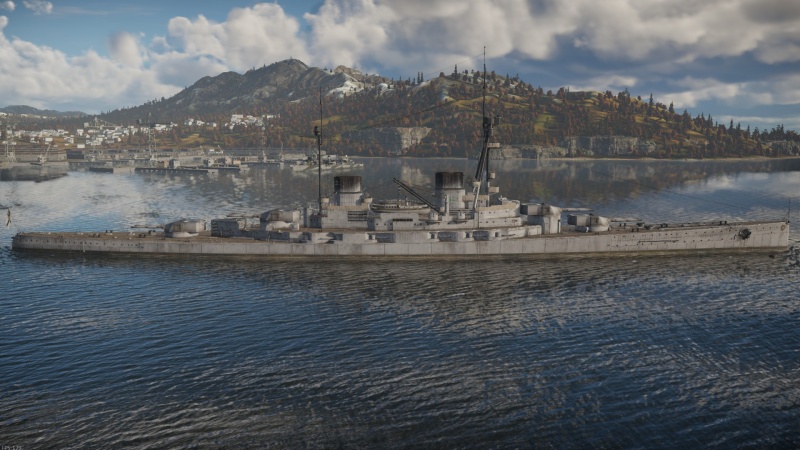SMS Derfflinger
Contents
Description
SMS Derfflinger was a German battlecruiser laid down in March 1911, commissioned during the First World War on 1 September 1914. Her first action was participation in the raid on Hartlepool, Scarborough, and Whitby in December 1914. She then fought at the Battle of Dogger Bank in January 1915. Finally, Derfflinger was also present at the Battle of Jutland from 31 May to 1 June 1916, where she engaged in the destruction of HMS Queen Mary and HMS Invincible, as well as damaged HMS Princess Royal and HMS Barham; however, she sustained significant damage herself. After repairs and a refit that included the installation of a tripod foremast, she returned to service on 15 October 1916. In October 1918, plans for a final naval operation included Derfflinger, but it was cancelled due to unrest among the crews. Following the Armistice, she was interned at Scapa Flow in November 1918 and was scuttled by her crew on 21 June 1919. Raised in late August 1939, she was towed to Faslane after the Second World War and scrapped there between 1946 and 1948.
The Derfflinger-class, SMS Derfflinger, 1916 is a German battlecruiser introduced in Update "Dance of Dragons". She features good mobility and good armour for a battlecruiser, while also sharing main guns with German battleships of the same BR, which give her formidable firepower, although with a lower number of individual cannons than most of her peers. Finally, her anti-air armament is extremely poor, making her an easy target for even large, slow-flying, four-engine bombers or even coastal vessels from reserve BRs, if they manage to avoid the 150 mm casemate guns.
General info
Survivability and armour
Talk about the vehicle's armour. Note the most well-defended and most vulnerable zones, e.g. the ammo magazine. Evaluate the composition of components and assemblies responsible for movement and manoeuvrability. Evaluate the survivability of the primary and secondary armaments separately. Don't forget to mention the size of the crew, which plays an important role in fleet mechanics. Save tips on preserving survivability for the "Usage in battles" section. If necessary, use a graphical template to show the most well-protected or most vulnerable points in the armour.
Mobility
Write about the ship's mobility. Evaluate its power and manoeuvrability, rudder rerouting speed, stopping speed at full tilt, with its maximum forward and reverse speed.
| Mobility Characteristics | |||
|---|---|---|---|
| Game Mode | Upgrade Status | Maximum Speed (km/h) | |
| Forward | Reverse | ||
| AB | |||
| Upgraded | 60 | 25 | |
| RB/SB | |||
| Upgraded | 52 | 22 | |
Modifications and economy
Armament
Primary armament
Provide information about the characteristics of the primary armament. Evaluate their efficacy in battle based on their reload speed, ballistics and the capacity of their shells. Add a link to the main article about the weapon: {{main|Weapon name (calibre)}}. Broadly describe the ammunition available for the primary armament, and provide recommendations on how to use it and which ammunition to choose.
| Penetration statistics | |||||||
|---|---|---|---|---|---|---|---|
| Ammunition | Type of warhead |
Penetration @ 0° Angle of Attack (mm) | |||||
| 1,000 m | 2,500 m | 5,000 m | 7,500 m | 10,000 m | 15,000 m | ||
| Spgr. L/3.8 Bdz | HE | 167 | 149 | 124 | 103 | 87 | 66 |
| Spgr. L/3.3 SAP | SAP | 481 | 430 | 357 | 299 | 252 | 193 |
| Psgr. L/3.4 | APC | 519 | 463 | 383 | 320 | 270 | 205 |
| Shell details | ||||||||||||
|---|---|---|---|---|---|---|---|---|---|---|---|---|
| Ammunition | Type of warhead |
Velocity (m/s) |
Projectile mass (kg) |
Fuse delay (s) |
Fuse sensitivity (mm) |
Explosive mass (TNT equivalent) (kg) |
Ricochet | |||||
| 0% | 50% | 100% | ||||||||||
| Spgr. L/3.8 Bdz | HE | 855 | 405.9 | 0.025 | 17 | 27 | 79° | 80° | 81° | |||
| Spgr. L/3.3 SAP | SAP | 850 | 410 | 0.025 | 17 | 10.8 | 47° | 60° | 65° | |||
| Psgr. L/3.4 | APC | 855 | 405.5 | 0.025 | 17 | 13.6 | 48° | 63° | 71° | |||
Secondary armament
Some ships are fitted with weapons of various calibres. Secondary armaments are defined as weapons chosen with the control Select secondary weapon. Evaluate the secondary armaments and give advice on how to use them. Describe the ammunition available for the secondary armament. Provide recommendations on how to use them and which ammunition to choose. Remember that any anti-air armament, even heavy calibre weapons, belong in the next section. If there is no secondary armament, remove this section.
| Penetration statistics | |||||||
|---|---|---|---|---|---|---|---|
| Ammunition | Type of warhead |
Penetration @ 0° Angle of Attack (mm) | |||||
| 1,000 m | 2,500 m | 5,000 m | 7,500 m | 10,000 m | 15,000 m | ||
| Sprgr. L/4.1 Kz | HE | 21 | 21 | 21 | 21 | 21 | 21 |
| Sprgr. L/4.1 Bdz | SAPBC | 95 | 80 | 61 | 47 | 37 | 28 |
| Psgr. L/3.7 | APCBC | 238 | 201 | 153 | 117 | 93 | 71 |
| Shell details | ||||||||||||
|---|---|---|---|---|---|---|---|---|---|---|---|---|
| Ammunition | Type of warhead |
Velocity (m/s) |
Projectile mass (kg) |
Fuse delay (s) |
Fuse sensitivity (mm) |
Explosive mass (TNT equivalent) (g) |
Ricochet | |||||
| 0% | 50% | 100% | ||||||||||
| Sprgr. L/4.1 Kz | HE | 835 | 45.3 | 0 | 0.1 | 1,600 | 79° | 80° | 81° | |||
| Sprgr. L/4.1 Bdz | SAPBC | 835 | 45.3 | 0.01 | 7 | 1,050 | 48° | 63° | 71° | |||
| Psgr. L/3.7 | APCBC | 835 | 45.3 | 0.015 | 7 | 990 | 48° | 63° | 71° | |||
Anti-aircraft armament
An important part of the ship's armament responsible for air defence. Anti-aircraft armament is defined by the weapon chosen with the control Select anti-aircraft weapons. Talk about the ship's anti-air cannons and machine guns, the number of guns and their positions, their effective range, and about their overall effectiveness – including against surface targets. If there are no anti-aircraft armaments, remove this section.
Additional armament
Describe the available additional armaments of the ship: depth charges, mines, torpedoes. Talk about their positions, available ammunition and launch features such as dead zones of torpedoes. If there is no additional armament, remove this section.
Usage in battles
Describe the technique of using this ship, the characteristics of her use in a team and tips on strategy. Abstain from writing an entire guide – don't try to provide a single point of view, but give the reader food for thought. Talk about the most dangerous opponents for this vehicle and provide recommendations on fighting them. If necessary, note the specifics of playing with this vehicle in various modes (AB, RB, SB).
Pros and cons
Summarise and briefly evaluate the vehicle in terms of its characteristics and combat effectiveness. Mark its pros and cons in the bulleted list. Try not to use more than 6 points for each of the characteristics. Avoid using categorical definitions such as "bad", "good" and the like - use substitutions with softer forms such as "inadequate" and "effective".
Pros:
Cons:
History
SMS Derfflinger was a German battlecruiser laid down in March 1911 at the Blohm & Voss shipyard in Hamburg. As part of the Imperial German Navy's expansion, she was designed with improved armour and armament to counter British naval power. Her comissioning took place on 1 September 1914, just 65 days after the beginning of the Great War.
On 16 December 1914, Derfflinger took part in the raid on the British coastal towns of Hartlepool, Scarborough, and Whitby. Alongside other German battlecruisers, she bombarded settlement, causing damage and a number of civilian casualties. The operation aimed to lure portions of the British Grand Fleet into engagements favourable to the Germans. Derfflinger also saw action at the Battle of Dogger Bank on 24 January 1915, where she engaged British battlecruisers and sustained minor damage.
During the Battle of Jutland on 31 May to 1 June 1916, SMS Derfflinger served as part of the German I Scouting Group (1. SG). Early in the engagement, at 15:49, Derfflinger scored two hits on the British battlecruiser HMS Princess Royal. At 16:21, she, along with SMS Seydlitz, targeted HMS Queen Mary, contributing to damage that led to Queen Mary's magazine explosion and sinking at 16:26, with the loss of all but twenty of her crew.
Around 17:00, Derfflinger hit the British battleship HMS Barham four times. Shortly after, at 17:19, she was struck on the forecastle by a shell from the British 5th Battle Squadron, causing damage, a fire, and flooding in the bow area. She sustained additional hits around 17:55, possibly two shells simultaneously, leading to further flooding. Between 18:26 and 18:30, Derfflinger was hit three times by HMS Indomitable, resulting in leaks and necessitating a brief stop to prevent her propellers from being fouled.
Later in the battle, at 18:32, Derfflinger, alongside SMS Lützow, engaged HMS Invincible, which exploded and sank. From 19:14 to 19:25, while leading the German battlecruisers, Derfflinger came under concentrated fire from the British fleet. She was hit fourteen times, suffering severe damage including the destruction of her aft turrets due to propellant fires and significant flooding from multiple shell impacts. Despite the damage, she was able to withdraw with the fleet. Following the battle, she underwent extensive repairs, during which she was fitted with a tripod foremast to enhance her fire-control capabilities, returning to service on 15 October 1916.
In late October 1918, plans for a final naval operation involving Derfflinger were cancelled due to unrest and mutiny among German naval crews. Following Germany's defeat, she was interned at Scapa Flow in November 1918. On 21 June 1919, Derfflinger was scuttled by her crew to prevent her seizure by the Allies. Raised in late August 1939, her scrapping was delayed by the outbreak of the Second World War. Eventually, she was towed to Faslane in Scotland and broken up between 1946 and 1948.
Media
Excellent additions to the article would be video guides, screenshots from the game, and photos.
See also
Links to articles on the War Thunder Wiki that you think will be useful for the reader, for example:
- reference to the series of the ship;
- links to approximate analogues of other nations and research trees.
External links
- [Wikipedia] SMS Derfflinger
- Aidan Dodson. Derfflinger: An Inverted Life pp. 175-178 Warship 2016. Conway.
- Aidan Dodson. The Kaiser's Battlefleet: German Capital Ships 1871-1918. Seaforth Publishing, 2016.
| Blohm & Voss | |
|---|---|
| Destroyers | |
| Type 1934A | Z15 Erich Steinbrinck |
| Heavy Cruisers | |
| Admiral Hipper-class | Admiral Hipper |
| Battlecruisers | |
| Unique Ships | SMS Von der Tann · SMS Derfflinger |
| See Also | Blohm & Voss Aircraft Division |
| Germany battlecruisers | |
|---|---|
| SMS Von der Tann* | |
| SMS Derfflinger* | |
| Scharnhorst-class | Scharnhorst |
| * Unique ship | |





